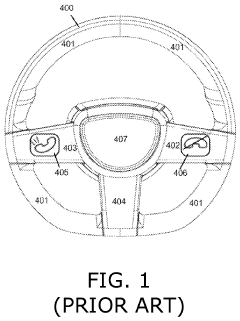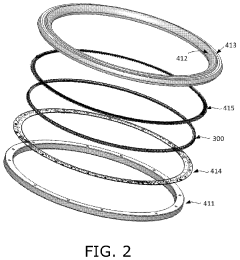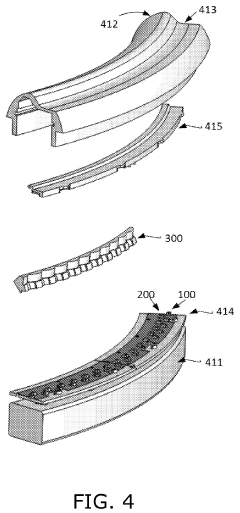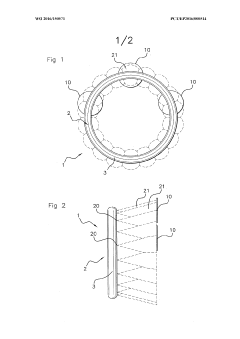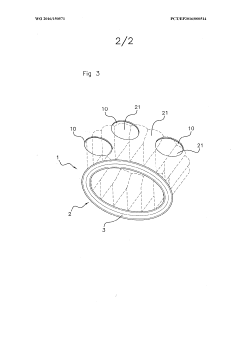Steering Wheel Features: Supporting Digital Connectivity
JUL 18, 20259 MIN READ
Generate Your Research Report Instantly with AI Agent
Patsnap Eureka helps you evaluate technical feasibility & market potential.
Steering Wheel Connectivity Evolution and Objectives
The evolution of steering wheel features supporting digital connectivity has been a significant trend in automotive technology over the past decade. This progression has been driven by the increasing demand for seamless integration of digital technologies into vehicles, enhancing both safety and user experience. The journey began with basic controls for audio systems and has now expanded to include advanced features such as voice recognition, touch-sensitive surfaces, and even biometric sensors.
Initially, steering wheels were equipped with simple buttons for controlling radio volume and changing stations. As infotainment systems became more complex, manufacturers introduced multi-function buttons to navigate through various menus and control a wider range of vehicle functions. This marked the beginning of the steering wheel's transformation into a central hub for driver interaction with the vehicle's digital systems.
The next significant leap came with the integration of voice control capabilities. This allowed drivers to access various functions without taking their hands off the wheel, greatly enhancing safety. Concurrently, the development of haptic feedback technology in steering wheels provided drivers with tactile responses, further reducing the need for visual confirmation of inputs.
Recent years have seen the introduction of touch-sensitive surfaces on steering wheels. These allow for more intuitive control of infotainment systems and digital displays, mimicking the familiar gestures used on smartphones and tablets. Some manufacturers have even experimented with small touchscreens embedded directly into the steering wheel, providing customizable interfaces for different driving modes or personal preferences.
The current frontier in steering wheel connectivity involves the integration of biometric sensors. These can monitor the driver's vital signs, detect fatigue, or even identify the driver for personalized settings and security purposes. This technology represents a significant step towards more intelligent and responsive vehicle systems.
Looking ahead, the objectives for steering wheel connectivity are focused on creating more intuitive, responsive, and personalized interfaces. There is a push towards developing steering wheels that can adapt their shape or feedback based on driving conditions or driver preferences. Additionally, there is ongoing research into incorporating augmented reality elements, potentially projecting important information directly onto or around the steering wheel.
Another key objective is to enhance the steering wheel's role in semi-autonomous and autonomous driving scenarios. As vehicles become more capable of self-driving, the steering wheel may evolve into a multifunctional controller for both manual and autonomous modes, seamlessly transitioning between the two as needed.
Initially, steering wheels were equipped with simple buttons for controlling radio volume and changing stations. As infotainment systems became more complex, manufacturers introduced multi-function buttons to navigate through various menus and control a wider range of vehicle functions. This marked the beginning of the steering wheel's transformation into a central hub for driver interaction with the vehicle's digital systems.
The next significant leap came with the integration of voice control capabilities. This allowed drivers to access various functions without taking their hands off the wheel, greatly enhancing safety. Concurrently, the development of haptic feedback technology in steering wheels provided drivers with tactile responses, further reducing the need for visual confirmation of inputs.
Recent years have seen the introduction of touch-sensitive surfaces on steering wheels. These allow for more intuitive control of infotainment systems and digital displays, mimicking the familiar gestures used on smartphones and tablets. Some manufacturers have even experimented with small touchscreens embedded directly into the steering wheel, providing customizable interfaces for different driving modes or personal preferences.
The current frontier in steering wheel connectivity involves the integration of biometric sensors. These can monitor the driver's vital signs, detect fatigue, or even identify the driver for personalized settings and security purposes. This technology represents a significant step towards more intelligent and responsive vehicle systems.
Looking ahead, the objectives for steering wheel connectivity are focused on creating more intuitive, responsive, and personalized interfaces. There is a push towards developing steering wheels that can adapt their shape or feedback based on driving conditions or driver preferences. Additionally, there is ongoing research into incorporating augmented reality elements, potentially projecting important information directly onto or around the steering wheel.
Another key objective is to enhance the steering wheel's role in semi-autonomous and autonomous driving scenarios. As vehicles become more capable of self-driving, the steering wheel may evolve into a multifunctional controller for both manual and autonomous modes, seamlessly transitioning between the two as needed.
Market Demand for Smart Steering Wheels
The market demand for smart steering wheels has been steadily increasing in recent years, driven by the growing trend of vehicle digitalization and connectivity. As automobiles evolve into mobile computing platforms, consumers are seeking more integrated and intelligent interfaces within their vehicles. Smart steering wheels represent a crucial touchpoint for drivers, offering enhanced control, safety features, and seamless connectivity with other vehicle systems and external devices.
Consumer surveys indicate a strong preference for steering wheels that can provide real-time information and control without requiring drivers to take their hands off the wheel or eyes off the road. This demand is particularly pronounced among younger demographics and tech-savvy consumers who expect their vehicles to offer the same level of connectivity and interactivity as their smartphones and other personal devices.
The automotive industry has recognized this shift in consumer expectations and is responding with increased investment in smart steering wheel technologies. Major automakers and tier-one suppliers are allocating significant resources to develop and integrate advanced features such as touch-sensitive controls, haptic feedback, and customizable displays directly into steering wheels.
Market analysts project that the global smart steering wheel market will experience substantial growth over the next decade. This growth is attributed to several factors, including the increasing adoption of advanced driver assistance systems (ADAS), the rise of electric and autonomous vehicles, and the overall trend towards more connected and intelligent transportation solutions.
One of the key drivers of market demand is the potential for smart steering wheels to enhance vehicle safety. Features such as driver monitoring systems integrated into the steering wheel can detect signs of fatigue or distraction, potentially reducing accidents caused by human error. This safety aspect has garnered attention from both consumers and regulatory bodies, further fueling the demand for these advanced steering systems.
Additionally, the push towards autonomous vehicles is paradoxically increasing the importance of steering wheel interfaces. As vehicles become more automated, the steering wheel is evolving into a critical communication point between the driver and the vehicle's AI systems. Consumers are showing interest in steering wheels that can seamlessly transition between manual and autonomous driving modes, providing intuitive controls and feedback throughout the journey.
The market demand extends beyond personal vehicles, with commercial fleets and ride-sharing services also expressing interest in smart steering wheel technologies. These sectors see potential in features that can improve driver performance, vehicle efficiency, and overall fleet management through real-time data collection and analysis facilitated by connected steering wheels.
Consumer surveys indicate a strong preference for steering wheels that can provide real-time information and control without requiring drivers to take their hands off the wheel or eyes off the road. This demand is particularly pronounced among younger demographics and tech-savvy consumers who expect their vehicles to offer the same level of connectivity and interactivity as their smartphones and other personal devices.
The automotive industry has recognized this shift in consumer expectations and is responding with increased investment in smart steering wheel technologies. Major automakers and tier-one suppliers are allocating significant resources to develop and integrate advanced features such as touch-sensitive controls, haptic feedback, and customizable displays directly into steering wheels.
Market analysts project that the global smart steering wheel market will experience substantial growth over the next decade. This growth is attributed to several factors, including the increasing adoption of advanced driver assistance systems (ADAS), the rise of electric and autonomous vehicles, and the overall trend towards more connected and intelligent transportation solutions.
One of the key drivers of market demand is the potential for smart steering wheels to enhance vehicle safety. Features such as driver monitoring systems integrated into the steering wheel can detect signs of fatigue or distraction, potentially reducing accidents caused by human error. This safety aspect has garnered attention from both consumers and regulatory bodies, further fueling the demand for these advanced steering systems.
Additionally, the push towards autonomous vehicles is paradoxically increasing the importance of steering wheel interfaces. As vehicles become more automated, the steering wheel is evolving into a critical communication point between the driver and the vehicle's AI systems. Consumers are showing interest in steering wheels that can seamlessly transition between manual and autonomous driving modes, providing intuitive controls and feedback throughout the journey.
The market demand extends beyond personal vehicles, with commercial fleets and ride-sharing services also expressing interest in smart steering wheel technologies. These sectors see potential in features that can improve driver performance, vehicle efficiency, and overall fleet management through real-time data collection and analysis facilitated by connected steering wheels.
Current Challenges in Steering Wheel Digitalization
The digitalization of steering wheels presents several significant challenges that automotive manufacturers and technology providers are currently grappling with. One of the primary obstacles is the integration of complex electronic systems into the limited space of a steering wheel without compromising its primary function or safety features. This requires innovative design solutions and miniaturization of components to accommodate sensors, displays, and control interfaces within the confines of the wheel structure.
Another major challenge lies in ensuring the reliability and durability of digital components in the harsh automotive environment. Steering wheels are subject to constant vibration, temperature fluctuations, and potential exposure to moisture or debris. Developing robust electronic systems that can withstand these conditions while maintaining consistent performance over the vehicle's lifetime is a significant engineering hurdle.
User interface design poses another critical challenge. As steering wheels become more digitally connected, there is a need to create intuitive and non-distracting interfaces that allow drivers to access information and controls without taking their hands off the wheel or eyes off the road. This involves careful consideration of ergonomics, haptic feedback, and voice control technologies to enhance usability while prioritizing safety.
Data security and privacy concerns also present significant challenges in the era of connected steering wheels. As these components become increasingly integrated with vehicle systems and potentially external networks, protecting sensitive information and preventing unauthorized access or control becomes paramount. Implementing robust cybersecurity measures without impacting system performance or user experience is a complex task.
The regulatory landscape surrounding digitalized steering wheels is another area of concern. As technology outpaces legislation, manufacturers must navigate a complex and evolving set of safety standards and regulations across different markets. Ensuring compliance while pushing the boundaries of innovation requires a delicate balance and close collaboration with regulatory bodies.
Cost considerations present yet another challenge. Incorporating advanced digital features into steering wheels inevitably increases production costs, which must be balanced against consumer demand and willingness to pay for these technologies. Manufacturers are tasked with finding cost-effective solutions that can be scaled across different vehicle models and price points.
Lastly, the challenge of backward compatibility and future-proofing cannot be overlooked. As vehicle lifespans extend and technology rapidly evolves, designing steering wheel systems that can be updated or upgraded over time becomes increasingly important. This requires flexible architectures and standardized interfaces that can accommodate future innovations without requiring complete system overhauls.
Another major challenge lies in ensuring the reliability and durability of digital components in the harsh automotive environment. Steering wheels are subject to constant vibration, temperature fluctuations, and potential exposure to moisture or debris. Developing robust electronic systems that can withstand these conditions while maintaining consistent performance over the vehicle's lifetime is a significant engineering hurdle.
User interface design poses another critical challenge. As steering wheels become more digitally connected, there is a need to create intuitive and non-distracting interfaces that allow drivers to access information and controls without taking their hands off the wheel or eyes off the road. This involves careful consideration of ergonomics, haptic feedback, and voice control technologies to enhance usability while prioritizing safety.
Data security and privacy concerns also present significant challenges in the era of connected steering wheels. As these components become increasingly integrated with vehicle systems and potentially external networks, protecting sensitive information and preventing unauthorized access or control becomes paramount. Implementing robust cybersecurity measures without impacting system performance or user experience is a complex task.
The regulatory landscape surrounding digitalized steering wheels is another area of concern. As technology outpaces legislation, manufacturers must navigate a complex and evolving set of safety standards and regulations across different markets. Ensuring compliance while pushing the boundaries of innovation requires a delicate balance and close collaboration with regulatory bodies.
Cost considerations present yet another challenge. Incorporating advanced digital features into steering wheels inevitably increases production costs, which must be balanced against consumer demand and willingness to pay for these technologies. Manufacturers are tasked with finding cost-effective solutions that can be scaled across different vehicle models and price points.
Lastly, the challenge of backward compatibility and future-proofing cannot be overlooked. As vehicle lifespans extend and technology rapidly evolves, designing steering wheel systems that can be updated or upgraded over time becomes increasingly important. This requires flexible architectures and standardized interfaces that can accommodate future innovations without requiring complete system overhauls.
Existing Digital Steering Wheel Features
01 Integration of digital displays in steering wheels
Modern steering wheels incorporate digital displays to provide real-time information to drivers. These displays can show various data such as vehicle speed, navigation instructions, and warning messages, enhancing the driver's situational awareness and improving overall driving experience.- Integration of digital interfaces in steering wheels: Modern steering wheels are incorporating digital interfaces, including touchscreens and control panels, to provide drivers with easy access to various vehicle functions and information. These interfaces allow for seamless interaction with infotainment systems, navigation, and vehicle settings without taking hands off the wheel.
- Wireless connectivity for steering wheel controls: Steering wheels are being equipped with wireless connectivity features, enabling communication between the steering wheel controls and the vehicle's central computer system. This allows for more flexible placement of controls and easier integration of new features without the need for complex wiring harnesses.
- Adaptive steering wheel displays: Advanced steering wheels now feature adaptive displays that can change based on driving conditions, user preferences, or vehicle mode. These displays can show different information or control layouts, enhancing the driver's situational awareness and providing a customizable interface.
- Integration of biometric sensors in steering wheels: Steering wheels are being designed with integrated biometric sensors to monitor driver health and alertness. These sensors can detect heart rate, skin conductivity, and other vital signs, potentially improving safety by alerting drivers to fatigue or health issues.
- Haptic feedback systems in steering wheels: Advanced haptic feedback systems are being incorporated into steering wheels to provide drivers with tactile alerts and information. These systems can communicate warnings, navigation directions, or other important information through vibrations or other tactile sensations, reducing the need for visual distractions.
02 Steering wheel-mounted controls for digital systems
Steering wheels are equipped with integrated controls that allow drivers to interact with various digital systems in the vehicle. These controls can include buttons, touchpads, or scroll wheels, enabling drivers to manage infotainment systems, adjust vehicle settings, and control communication devices without taking their hands off the wheel.Expand Specific Solutions03 Wireless connectivity for steering wheel systems
Steering wheels incorporate wireless connectivity technologies to communicate with other vehicle systems and external devices. This allows for seamless integration of smartphone features, cloud-based services, and over-the-air updates for steering wheel-mounted systems.Expand Specific Solutions04 Haptic feedback systems in steering wheels
Advanced steering wheels feature haptic feedback systems that provide tactile sensations to the driver. These systems can alert the driver to potential hazards, provide navigation cues, or enhance the overall driving experience through programmable vibrations or force feedback.Expand Specific Solutions05 Adaptive steering wheel interfaces
Steering wheels are designed with adaptive interfaces that can change their functionality based on driving conditions, user preferences, or vehicle mode. This includes reconfigurable displays, context-sensitive controls, and personalized settings that adjust to individual drivers or driving scenarios.Expand Specific Solutions
Key Players in Automotive Connectivity Solutions
The steering wheel digital connectivity market is in a growth phase, with increasing demand for smart, connected vehicle interfaces. The market size is expanding rapidly as automakers integrate more digital features into steering wheels. Technologically, the field is advancing quickly but still evolving, with varying levels of maturity among different features. Companies like Continental Automotive, ZF Automotive, and BMW are at the forefront, developing advanced steering wheel technologies that incorporate touch sensors, haptic feedback, and integrated displays. Other players like Autoliv, Preh, and Kostal are also making significant contributions, focusing on safety features and user interface innovations. The competitive landscape is dynamic, with both established automotive suppliers and newer tech-focused entrants vying for market share.
Continental Automotive GmbH
Technical Solution: Continental has developed an advanced steering wheel system that integrates digital connectivity features. Their solution includes a touch-sensitive steering wheel rim with haptic feedback, allowing drivers to control various vehicle functions without taking their hands off the wheel[1]. The system incorporates capacitive touch sensors and micro-LEDs embedded in the steering wheel, enabling intuitive gesture controls and providing visual feedback[2]. Continental's technology also supports driver monitoring through integrated cameras and sensors, enhancing safety by detecting driver distraction or fatigue[3]. Additionally, their steering wheel design incorporates customizable displays that can show relevant information such as navigation instructions, media controls, and vehicle status updates directly on the steering wheel surface[4].
Strengths: Intuitive user interface, enhanced safety features, customizable displays. Weaknesses: Potential for driver distraction, higher cost compared to traditional steering wheels.
ZF Automotive Germany GmbH
Technical Solution: ZF has introduced a steering wheel concept that supports digital connectivity through their "Hands On Detection" (HOD) technology. This system uses capacitive sensing to detect the driver's hands on the steering wheel, crucial for advanced driver assistance systems and autonomous driving features[5]. ZF's steering wheel integrates illuminated touch-sensitive controls that can be reconfigured based on the driving mode or user preferences[6]. The company has also developed a steer-by-wire system that enables more flexible steering wheel designs, including retractable wheels for autonomous driving scenarios[7]. ZF's technology incorporates advanced haptic feedback mechanisms to provide tactile responses to driver inputs, enhancing the user experience and safety[8].
Strengths: Advanced hand detection technology, flexible design for autonomous vehicles. Weaknesses: Reliance on complex electronic systems, potential cybersecurity concerns.
Innovative Connectivity Technologies for Steering Wheels
Vehicle user interface
PatentActiveUS20200348831A1
Innovation
- A steering wheel with a circular gripping element and an array of light-based proximity sensors that detect gestures without the need for absolute positioning, allowing for relative positioning-based user interactions independent of wheel rotation.
Vehicle steering-wheel assembly including means for communicating by emitting and receiving light
PatentWO2016150571A1
Innovation
- A steering wheel assembly with distributed infrared light emission sources and sensors forming a continuous communication channel, ensuring uninterrupted data transmission and hand presence detection, using adjustable light sources and sensors to maintain connectivity despite rotation.
Safety and Regulatory Considerations
The integration of digital connectivity features into steering wheels raises significant safety and regulatory considerations. As these advanced technologies become more prevalent, manufacturers must navigate a complex landscape of safety standards and regulatory requirements to ensure that these innovations do not compromise driver safety or violate existing regulations.
From a safety perspective, the primary concern is driver distraction. Steering wheel-mounted controls and displays must be designed to minimize cognitive load and visual diversion from the road. This necessitates careful ergonomic design and intuitive user interfaces that allow drivers to access digital features without taking their hands off the wheel or eyes off the road for extended periods. Haptic feedback and voice control technologies are being explored as potential solutions to reduce visual distraction.
Regulatory bodies, such as the National Highway Traffic Safety Administration (NHTSA) in the United States and the European New Car Assessment Programme (Euro NCAP), are actively developing guidelines and standards for in-vehicle digital systems. These regulations often focus on limiting the complexity of tasks that can be performed while driving and setting standards for response times and error rates of digital interfaces.
Cybersecurity is another critical consideration as steering wheels become more connected. The potential for malicious actors to gain control of vehicle systems through vulnerabilities in digital interfaces poses a significant safety risk. Manufacturers must implement robust security measures and regularly update software to protect against evolving threats.
Data privacy regulations, such as the General Data Protection Regulation (GDPR) in Europe, also impact the development of connected steering wheel features. As these systems collect and process personal data, including driving patterns and preferences, manufacturers must ensure compliance with data protection laws and provide transparent information to users about data collection and usage.
Electromagnetic compatibility (EMC) is a technical challenge that must be addressed to meet regulatory standards. The integration of electronic components into the steering wheel must not interfere with other vehicle systems or external devices, requiring thorough testing and compliance with EMC regulations.
As autonomous driving technologies advance, regulations surrounding the transition between automated and manual control become increasingly relevant. Steering wheel designs must incorporate features that facilitate smooth and safe handovers between human drivers and autonomous systems, adhering to emerging standards in this area.
Manufacturers must also consider the global nature of the automotive market, as regulations can vary significantly between countries and regions. Developing steering wheel features that can be easily adapted to meet diverse regulatory requirements while maintaining a consistent user experience across markets is a complex challenge.
From a safety perspective, the primary concern is driver distraction. Steering wheel-mounted controls and displays must be designed to minimize cognitive load and visual diversion from the road. This necessitates careful ergonomic design and intuitive user interfaces that allow drivers to access digital features without taking their hands off the wheel or eyes off the road for extended periods. Haptic feedback and voice control technologies are being explored as potential solutions to reduce visual distraction.
Regulatory bodies, such as the National Highway Traffic Safety Administration (NHTSA) in the United States and the European New Car Assessment Programme (Euro NCAP), are actively developing guidelines and standards for in-vehicle digital systems. These regulations often focus on limiting the complexity of tasks that can be performed while driving and setting standards for response times and error rates of digital interfaces.
Cybersecurity is another critical consideration as steering wheels become more connected. The potential for malicious actors to gain control of vehicle systems through vulnerabilities in digital interfaces poses a significant safety risk. Manufacturers must implement robust security measures and regularly update software to protect against evolving threats.
Data privacy regulations, such as the General Data Protection Regulation (GDPR) in Europe, also impact the development of connected steering wheel features. As these systems collect and process personal data, including driving patterns and preferences, manufacturers must ensure compliance with data protection laws and provide transparent information to users about data collection and usage.
Electromagnetic compatibility (EMC) is a technical challenge that must be addressed to meet regulatory standards. The integration of electronic components into the steering wheel must not interfere with other vehicle systems or external devices, requiring thorough testing and compliance with EMC regulations.
As autonomous driving technologies advance, regulations surrounding the transition between automated and manual control become increasingly relevant. Steering wheel designs must incorporate features that facilitate smooth and safe handovers between human drivers and autonomous systems, adhering to emerging standards in this area.
Manufacturers must also consider the global nature of the automotive market, as regulations can vary significantly between countries and regions. Developing steering wheel features that can be easily adapted to meet diverse regulatory requirements while maintaining a consistent user experience across markets is a complex challenge.
Human-Machine Interface Design for Smart Steering Wheels
The design of human-machine interfaces for smart steering wheels is a critical aspect of modern automotive technology, focusing on enhancing driver interaction and safety through digital connectivity. As vehicles become increasingly connected and autonomous, steering wheels are evolving into sophisticated control centers that integrate various functions and information displays.
Smart steering wheels typically incorporate touch-sensitive surfaces, haptic feedback mechanisms, and integrated displays to provide drivers with intuitive access to vehicle controls and information. These interfaces are designed to minimize driver distraction while maximizing the accessibility of essential features. For instance, touch-sensitive areas on the steering wheel rim can allow drivers to control infotainment systems, adjust cruise control settings, or activate voice commands without removing their hands from the wheel.
Haptic feedback plays a crucial role in smart steering wheel interfaces, providing tactile responses to user inputs and alerts. This technology can convey important information to the driver through vibrations or subtle changes in texture, reducing the need for visual attention and enhancing safety. For example, lane departure warnings can be communicated through steering wheel vibrations, allowing drivers to react quickly without taking their eyes off the road.
Integrated displays within the steering wheel are becoming more prevalent, offering customizable information panels that can show everything from navigation instructions to vehicle status updates. These displays are often designed with high contrast ratios and anti-glare coatings to ensure visibility in various lighting conditions. The placement and size of these displays are carefully considered to provide optimal viewing angles without obstructing the driver's line of sight.
Voice recognition and natural language processing are increasingly integrated into smart steering wheel designs, allowing drivers to control various vehicle functions through voice commands. This hands-free interaction method further enhances safety by reducing the need for manual inputs. Advanced systems can even interpret contextual cues and driver preferences to provide more personalized and efficient responses.
Ergonomics plays a vital role in the design of smart steering wheel interfaces. The placement of controls, the texture of surfaces, and the overall shape of the wheel are all optimized to ensure comfort and ease of use during long periods of driving. Designers must balance the integration of new technologies with the fundamental purpose of the steering wheel as a control device for vehicle direction.
As vehicles transition towards higher levels of autonomy, the role of the steering wheel is evolving. Future designs may incorporate features that support the transition between manual and autonomous driving modes, such as retractable steering wheels or shape-shifting interfaces that adapt to different driving scenarios. These advanced concepts aim to create a seamless experience as drivers shift between active control and passive monitoring of vehicle operations.
Smart steering wheels typically incorporate touch-sensitive surfaces, haptic feedback mechanisms, and integrated displays to provide drivers with intuitive access to vehicle controls and information. These interfaces are designed to minimize driver distraction while maximizing the accessibility of essential features. For instance, touch-sensitive areas on the steering wheel rim can allow drivers to control infotainment systems, adjust cruise control settings, or activate voice commands without removing their hands from the wheel.
Haptic feedback plays a crucial role in smart steering wheel interfaces, providing tactile responses to user inputs and alerts. This technology can convey important information to the driver through vibrations or subtle changes in texture, reducing the need for visual attention and enhancing safety. For example, lane departure warnings can be communicated through steering wheel vibrations, allowing drivers to react quickly without taking their eyes off the road.
Integrated displays within the steering wheel are becoming more prevalent, offering customizable information panels that can show everything from navigation instructions to vehicle status updates. These displays are often designed with high contrast ratios and anti-glare coatings to ensure visibility in various lighting conditions. The placement and size of these displays are carefully considered to provide optimal viewing angles without obstructing the driver's line of sight.
Voice recognition and natural language processing are increasingly integrated into smart steering wheel designs, allowing drivers to control various vehicle functions through voice commands. This hands-free interaction method further enhances safety by reducing the need for manual inputs. Advanced systems can even interpret contextual cues and driver preferences to provide more personalized and efficient responses.
Ergonomics plays a vital role in the design of smart steering wheel interfaces. The placement of controls, the texture of surfaces, and the overall shape of the wheel are all optimized to ensure comfort and ease of use during long periods of driving. Designers must balance the integration of new technologies with the fundamental purpose of the steering wheel as a control device for vehicle direction.
As vehicles transition towards higher levels of autonomy, the role of the steering wheel is evolving. Future designs may incorporate features that support the transition between manual and autonomous driving modes, such as retractable steering wheels or shape-shifting interfaces that adapt to different driving scenarios. These advanced concepts aim to create a seamless experience as drivers shift between active control and passive monitoring of vehicle operations.
Unlock deeper insights with Patsnap Eureka Quick Research — get a full tech report to explore trends and direct your research. Try now!
Generate Your Research Report Instantly with AI Agent
Supercharge your innovation with Patsnap Eureka AI Agent Platform!
